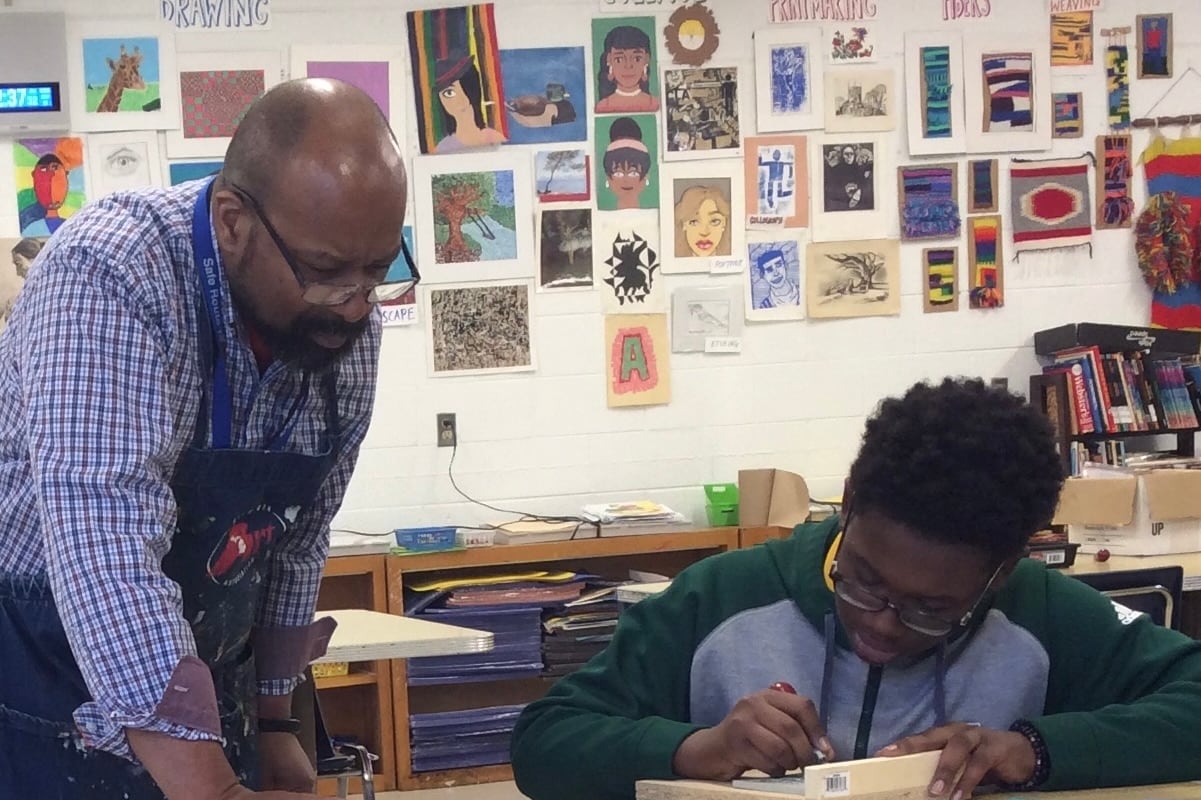Illya Tolbert loved art so much growing up that he and his brother Yul would often race around their Detroit home searching for something — anything — they could draw on.
When he wasn’t finding inspiration at home, he was finding it in the classroom, learning from the art teachers who became his favorite instructors in Detroit Public Schools.
“There are lessons that I learned from my art teacher, back in the seventh grade that I’m now teaching, which I think is kind of cool,” said Tolbert. That teacher was Mary Kay Shelton, and the lessons Tolbert adapted for his own classrooms at Bates Academy include learning concepts such as linear perspective and optical illusions.
Over the course of an art teaching career that has spanned 26 years, Tolbert — Michigan’s middle school Art Educator of the Year for 2022 — has sought to inspire students with art forms such as painting, weaving, and animation.
“Me and my brother loved animation,” he said. “We used to make these little flip books at home and the process of making things move, to get that illusion of movement, it just intrigues me. I love it.”
Tolbert has decorated the walls of his classroom with his students’ pieces, but you would have to search to find his own artwork. He says he only has one piece hanging.
“Maybe it’s modesty. I don’t know,” Tolbert said. “I would rather show [the work of] a former student or a famous artist.”
Chalkbeat recently caught up with Tolbert to talk about art, his career, and the popular YouTube videos he created for his students during COVID closures.
The interview has been lightly edited for length and clarity.
How and when did you decide to become a teacher?
My art teachers were always like my favorite teachers. And I always considered going into art teaching. I had a bachelor’s of fine arts degree from Wayne State University, and I was out of school for a year or so when I said, ‘Let’s go back and do the thing I always wanted to do — become a teacher.’
What was drawing you to teach art?
I’ve always loved art. Me and my brother, we always drew cartoons. We made our own characters. As a kid, nothing was more fun than sitting down and drawing. I always remember what I learned in art when I went to Detroit Public Schools, and I feel like I could have learned so much more. I knew that my teachers in Detroit didn’t have all the materials and things, and I just always wanted to be able to give kids what I wanted as a student.
What is something you always wanted to learn in art classes as a student?
Animation. I teach animation now, and my classes are … obsessed with cartoons. I can teach it now because it’s so much easier. The technology is so much easier to teach now than it was back when I was a kid. I also like teaching painting. I feel like we didn’t paint enough when I was in school. And now, I probably paint every day in my classroom. Painting is what I do as an artist. I’ve just felt that kids in Detroit should have exposure to other things like that in art.
What’s your favorite lesson to teach and why?
I’m going to go with weaving. Every year I teach weaving on a cardboard loom. When I say we’re weaving, the class will applaud. The kids are happy. “We’re weaving!” When I first started teaching it, I was like, ‘Why is this so popular?’ I didn’t think the kids would like it that much. I also enjoy it. I learned weaving in school at Wayne State in a fibers class. It was stitching and sewing, and that was okay. But weaving, I just loved weaving, I was drawn to it. I think somewhere in my ancestry, one of my ancestors in Africa must have been a weaver.
How do you inspire your students?
I very rarely show them my own personal art, but I will show them what other students have done. My walls are covered with former students’ artwork. A lot of times they give you their work, and sometimes they just leave it, and I end up keeping it. When they discover I put their artwork on the wall, they get so excited. [The artwork] is a good way to show students what can be done. I like to have it intermixed — like, I have a Van Gogh that’s right next to one of my student’s art. I have an example of work done by Monet next to my student’s art. Just to show, hey, there’s this famous artist, and here’s an artist who used to go here.
You have a busy job, and this is a stressful time. How do you take care of yourself when you’re not at work?
I like to paint. I like to spend time with my wife. And I do enjoy playing computer games. Not so much your video system games, but strategy games, like SimCity, where you’re building a civilization — those kinds of games that take hours to play.
Tell me about the YouTube channel you created to help students learn remotely.
The way that I teach art is I always stay in front of the class and do the project with them.— especially elementary level, but even middle school. I’ll do it with them to show them step-by-step how it’s done. Or, with middle school, I’ll just sit there and do the project and say, ‘OK, now you do it.’ This was hard to do virtually. So I started making these movies. And they worked out really well to show them step-by-step how to do various projects. I mean, they were so popular, the kids would go straight to the video before I even started talking. I’d be like, ‘Wait, let me at least talk about it first.’








